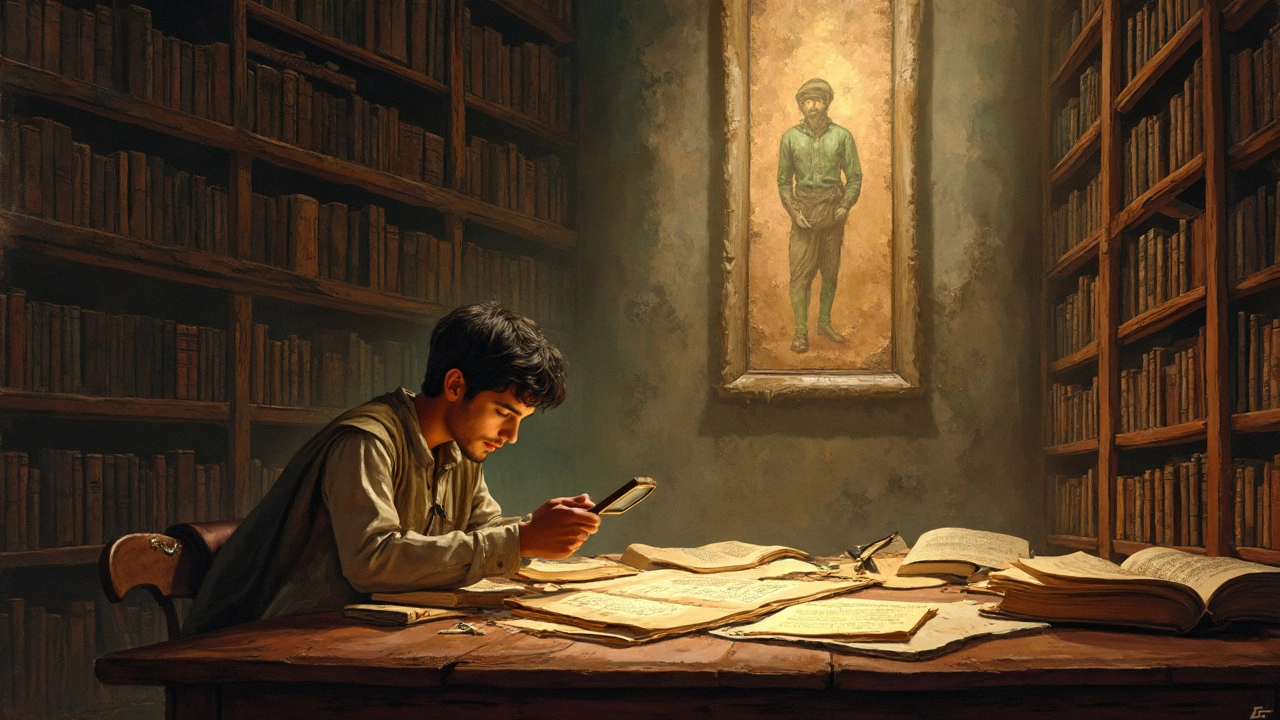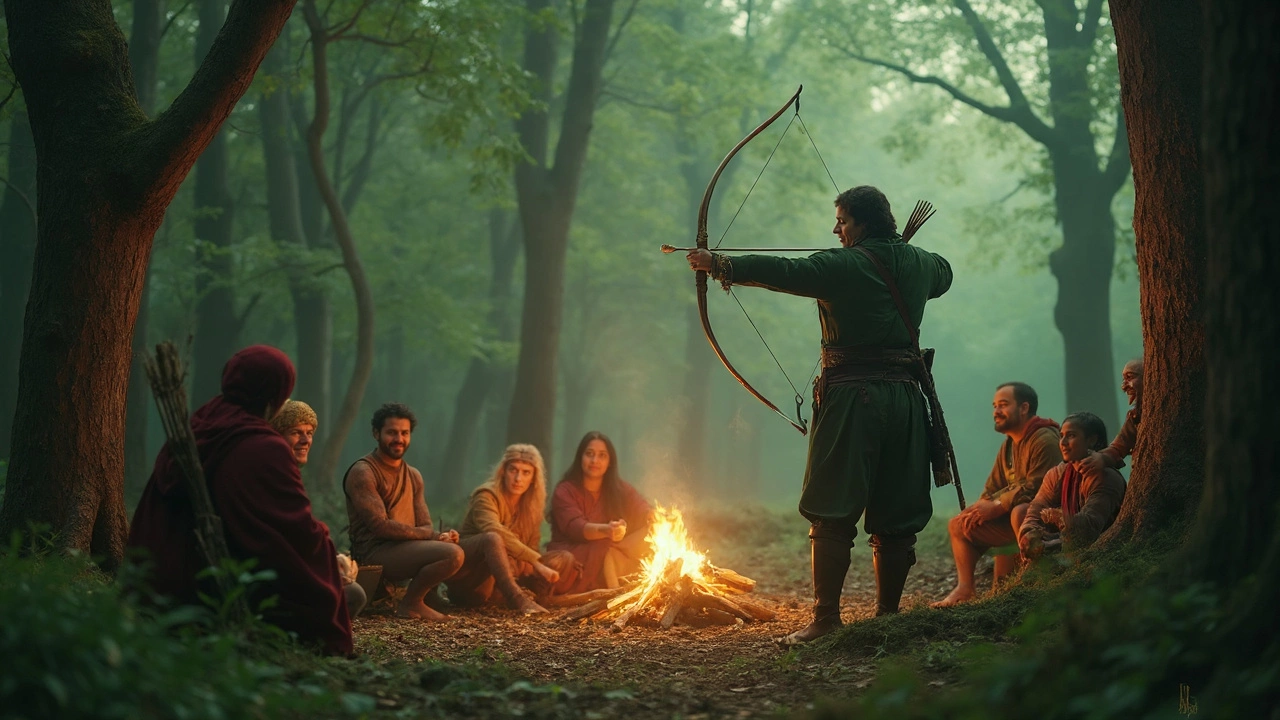Ask ten people about Robin Hood, and you'll get ten wildly different answers. Some swear he was real, others say he's pure fiction, and a few just remember Kevin Costner running through the woods. But here's the thing—it actually matters whether Robin Hood is a myth, a legend, or something in between. This isn't only about splitting hairs. It changes how we see history, storytelling, and even what we expect from heroes.
When you read about Robin Hood, it's easy to get lost in the mix of ballads, movies, and TV shows. But if you want the truth (or as close as anyone can get), you have to ask the right questions first. Was Robin Hood someone real, or was he just a story people needed at the time? Getting to the bottom of this is more than a pub trivia night question. It's a way to see how stories grow, why they last, and how they shape the way we look at justice and rebellion.
- What Makes Something a Myth or a Legend?
- Robin Hood in Old Stories and Songs
- Looking for the Real Robin Hood
- What the History Books Actually Say
- How Movies and TV Changed the Tale
- Why Robin Hood Still Matters
What Makes Something a Myth or a Legend?
So, what’s the difference between a myth and a legend anyway? People use those words a lot, but they’re not the same thing. A myth usually means a story that explains big ideas, like where the world comes from or why things are the way they are. Myths often have gods, monsters, and wild stuff happening—think Greek gods or Norse giants. Legends are different. They tell the story of a person or event that might be real, but the details have gotten seriously stretched or changed over time.
Here’s the big tip-off: If a story is more about teaching a lesson or explaining the world, it’s probably a myth. If it’s about someone who maybe actually lived, but the story’s been supercharged with drama, that’s a legend.
Folklore expert Linda Dégh once said, "Legends operate between belief and disbelief—they might be true, and that’s what keeps them alive."
It gets even more interesting when you look at which stories stay local and which ones spread out. Some stories stay in just one town for hundreds of years; others, like Robin Hood, make it to the big leagues and get told all over the place. Here’s how myths and legends stack up in a few key ways:
| Feature | Myth | Legend |
|---|---|---|
| Main point | Explains big ideas or origins | Focuses on a possibly real person/event |
| Characters | Usually gods, creatures, heroes | Humans, sometimes with real names |
| Truth factor | No evidence needed | May have some historical basis |
| How stories spread | By tradition, mostly oral | Oral and written, records often exist |
The thing is, legends usually start close to the truth, but after telling and retelling, the facts blur. Same with Robin Hood—the basics may be rooted in history, but all the archery contests and green tights? That’s people adding fun for the ages. When you start thinking about whether Robin Hood is a myth or a legend, pay attention to which parts try to teach a lesson and which parts lean on history. That makes all the difference for figuring out what sort of story you’ve actually got.
Robin Hood in Old Stories and Songs
Before Robin Hood was a movie star, his story lived in songs and stories passed around villages. The earliest mentions pop up in old English ballads from the 1300s, like “Robin Hood and the Monk” and “A Gest of Robyn Hode.” People would sing these tunes at fairs, and the stories did something strange — they kept changing. Some versions made Robin a rebellious outlaw, while others painted him as a loyal servant to the poor.
The stories didn’t get written down at first. Back then, printing was rare, so news traveled by word of mouth and song. But when printing did get going, collections of ballads exploded by the 1500s. One of the earliest printed books, called “A Gest of Robyn Hode,” became a hit. This one’s huge — over 1,800 lines. It mixes jokes, drama, and fights, plus Robin’s nonstop beef with the Sheriff of Nottingham. Later versions added sidekicks like Little John and Friar Tuck, and even Maid Marian by the 1600s.
- The original Robin Hood ballads didn’t mention rich-vs-poor charity at all — that idea took time to grow.
- No single place is locked in for Robin’s adventures; Sherwood Forest is famous now, but places like Barnsdale show up a lot too.
- Names and details often flip. Sometimes Robin’s a dispossessed nobleman; sometimes just a regular guy fed up with the system.
Here’s a quick look at when some of the big Robin Hood stories showed up:
| Story/Song | Date | Key Fact |
|---|---|---|
| Robin Hood and the Monk | c. 1450 | Earliest surviving ballad in manuscript form |
| A Gest of Robyn Hode | c. 1500 | First printed "mega-story," shaped later tales |
| Robin Hood and Guy of Gisborne | late 1400s | Robin faces off with a rival outlaw |
| Robin Hood and the Potter | c. 1468 | Shows Robin outsmarting townsfolk |
So, is Robin Hood a myth or legend here? These early songs didn’t seem worried about facts. They aimed to entertain, teach a little, and maybe poke fun at folks in power. The details might not match up, but the spirit of Robin Hood still comes through strong in every version: he’s clever, quick with a bow, and always up for a challenge.
Looking for the Real Robin Hood
If you go hunting in old English records hoping to find the real Robin Hood, good luck—nobody has turned up a birth certificate for this famous outlaw. Still, that hasn’t stopped researchers, historians, or even casual fans from digging through court records and old ballads for a clue. The truth? There’s just no concrete proof one single person named Robin Hood pulled off all those legendary stunts in Sherwood Forest.
That said, folks in the Middle Ages really were talking about someone called Robin (or Robyn) Hood. The name pops up in court records as early as the 1200s, but it’s more like spotting "John Doe" in today’s paperwork. Turns out, "Robin Hood" became a stand-in for any outlaw, kind of like a nickname for a troublemaker. In a court roll from 1262 in Yorkshire, there’s a record of a "Robert Hod," who was an outlaw, but he vanishes after a few lines. It’s not exactly the stuff of movies, but it’s the closest thing we have.
Here’s the tricky part: different historians point in different directions. Some say Robin Hood was inspired by a real guy who lived around Wakefield or Barnsdale. Others link him to a rebel fighting the government in the 14th century. But nobody can agree, and nobody has found the smoking gun—no forest hideout, no hand-carved bow, not even a signature on some loot. Historian J.C. Holt summed it up best:
“Robin Hood was not a single man but a symbol. There are many real outlaws who might have inspired him, but none who can claim the full legend.”
If you’re hoping to spot the real Robin Hood in the historical record, get ready for wild goose chases and dead ends. It doesn’t mean he’s pure myth, but it does mean he’s probably not just one guy. The hunt for the real Robin Hood is basically the start of the story, not the answer to it.

What the History Books Actually Say
This is where things get tricky. If you crack open a history book looking for clear proof that Robin Hood rode through Sherwood Forest, you’re out of luck. There’s no single guy with the name "Robin Hood" in official records from medieval England who fits the ballad’s timeline—at least, not exactly as the stories tell it.
The earliest stories about Robin Hood pop up in the 1300s, but even then, they talk about him like he’s already a folk hero. By that time, ‘Robin Hood’ was almost like an alias—sort of the “John Doe” of outlaws. According to old court records, you’ll see a bunch of guys with similar names: Robehod, Robert Hood, Robin Hude, and more. These weren’t all the same person, and some may have just taken on the name after the stories got popular. Historians found dozens of records mentioning petty criminals named “Robinhood” or something close, stretching across England. So, nobody can point to one single Robin Hood and say “yep, this is him, this is the Robin Hood.”
Here's a quick breakdown of key "Robin Hoods" in history:
| Name | Date | Location | Notable Fact |
|---|---|---|---|
| Robyn Hode | 1225 | Yorkshire | First real-life record, listed as a fugitive |
| Robert Hod | 1261 | York | Name changed to "Hobbehod" in the records, possibly becoming a legend |
| Robin Hood | 1354 | Wiltshire | Mentioned in legal documents as an alias |
Medieval England was actually full of outlaws, so stories like Robin Hood were probably inspired by many folks, not just one. When books and broadsheets started romanticizing Robin’s adventures in the 1400s and 1500s, he was suddenly robbing from the rich and giving to the poor—something older stories don’t even mention.
If you want to get closer to the truth, the best tip is to look at the wider context—medieval ballads, court files, and what regular people thought of outlaws at the time. History books agree on one thing: Robin Hood is a mix of names, real outlaw stories, and a good helping of wishful thinking. There’s no smoking gun, but there sure is a long trail of breadcrumbs.
How Movies and TV Changed the Tale
If you ask most people to picture Robin Hood, chances are they're thinking of something straight out of a movie or TV show. Hollywood gave us the guy in Lincoln green tights, a British accent, and a perfect aim with a bow. But that slick image is really a modern remix, not the raw story from old ballads. The Robin Hood we see today is way more about entertainment than original history.
The first big Hollywood splash was "The Adventures of Robin Hood" with Errol Flynn in 1938. This movie stamped Robin as the chiseled, grinning hero sticking it to the evil Sheriff of Nottingham. Flynn’s version basically invented the charismatic outlaw with charm, jokes, and wild swordfights. Then came Disney’s 1973 cartoon, turning Robin into a wisecracking fox—literally. These versions set the tone for what most kids and even adults now expect from any Robin Hood story.
TV wasn't far behind. The British series "Robin of Sherwood" (1984–1986) added a mystical vibe, mixing in forest spirits and magic. It’s the first time modern audiences saw Robin Hood as almost a superhero with a deeper backstory. With every new series or movie, more layers got added—sometimes stealing from real English history, sometimes just making things up to fit the times.
Here’s the wild part: every era shapes Robin Hood to match what people want. In the 1990s, "Robin Hood: Prince of Thieves" (yep, the Kevin Costner one) threw in American accent, over-the-top villains, and a huge budget. Fast forward, and you’ve got everything from Russell Crowe’s gritty 2010 take to satirical spoofs poking fun at the legend.
It’s not just about fun and games. As historian Stephen Knight put it,
"Robin Hood survives because he’s the most flexible of heroes. Hollywood turns him into whatever suits the mood of an audience looking for hope—or just a good story."
So, the Robin Hood that lives on screens is a moving target, constantly shifting to fit new values and tastes. That’s why people keep rediscovering him, and why the old outlaw isn’t going anywhere soon.
Why Robin Hood Still Matters
The Robin Hood story has stuck around for over 700 years. That's not just because he wore green and liked archery. It matters because every generation finds something new in his story—sometimes it’s about standing up to unfair leaders, other times it’s about teamwork, or sticking up for the underdog. Even in 2025, people know exactly what you mean when you say, "rob from the rich, give to the poor." That catchphrase has outlived most politicians.
Look at times when there was a big gap between rich and poor. Robin Hood’s story popped up more—in the industrial revolution, right after World War II, again during the 2008 financial crash, and even today. People love a hero who breaks the rules when the rules seem broken. It’s comfort food for anyone who feels like the system isn’t fair.
Here’s some hard proof. The name "Robin Hood" has been used on everything from charity funds to protest movements. In 2011, the European Union had serious talks about a "Robin Hood tax"—a real-world policy about taxing financial deals to help the poor. Look up sports teams, local pubs, or festivals, and I bet there’s a Robin Hood somewhere in your country, even outside England.
Schools use Robin Hood stories to teach about justice and ethics. Teachers like that the story opens up talks about right and wrong and how sometimes rules clash with what’s fair. Plus, Robin Hood stories are a way in for kids who don’t really click with typical history lessons.
| Fact | Details |
|---|---|
| Oldest Robin Hood ballads | First written records date from the 1400s |
| Robin Hood tax campaign | Over 1000 economists backed it worldwide in 2011 |
| Film & TV adaptations | Over 120 filmed versions since 1908 |
| Pubs named after Robin Hood (UK) | More than 200 as of 2023 |
If you want to dig deeper, try reading a few of those old ballads (some are free online) or check out documentaries on the history channel. You might be surprised how much the story changes with every generation. Bottom line—Robin Hood keeps popping up wherever people care about fairness, and that’s not going away any time soon.

